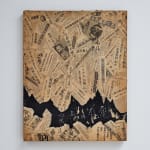Ishikawa Kyuyoh (b. 1945)
1967
53 x 42 cm
Exhibitions
The 2nd Yūgetsukai exhibition. Kyoto: Gallery Maronie, 1967.
Ishikawa Kyuyoh: The Complete Works. Tokyo: Ueno Royal Museum, 2024.
Literature
Ishikawa Kyuyoh: The Complete Works. vol. 1. Kyoto: Shibunkaku Publishing, 2024.
On a surface covered with various newspaper cuttings, pasted upright or at diagonals, the artist places a striking black shape that appears to rip through the lower portion of the image. There, in faint, scratchy brushstrokes, he writes the characters for Kiretsu no danshō (torn chapter), the title of this work.
The upper two-thirds of the image contain newspaper fragments, including a picture of a shouting man, along with headlines related to international affairs and politics, such as “records of war,” “menace,” and “Vietnam.” By contrast, in the roughly one-fifth of the work below the black area, words such as “good fortune” and “friendship,” along with phrases like “because of love…” “I am satisfied,” “living room,” and “everyone’s…” catch the viewer’s eye, creating a more private and emotional zone.
A black divide runs between the sphere of politics and power, and the emotions of ordinary, real people. While this work strongly references to the political situation of the time, it also reflects the artist’s intent to draw a deep line between the world of overwhelming political forces and the spirit of the artist.
Ishikawa Kyuyoh (calligrapher; b. 1945)
Born in Fukui Prefecture, Japan in 1945. Graduated from the Faculty of Law at Kyoto University. After serving as a professor at Kyoto Seika University and the director of the Institute for Writing and Civilizations, he is now an emeritus professor at the same university. Ishikawa has elucidated the concept that “calligraphy is the art of hisshoku (taction),” and interprets the structure and history of calligraphy. As a critic, he is also active in discussions on the Japanese language and culture, which have had a significant impact across various fields. In both his artistic creations and written works, Ishikawa continues to produce cutting-edge expressions and insights. His body of work includes over 2,000 calligraphic pieces and more than 100 published books.



